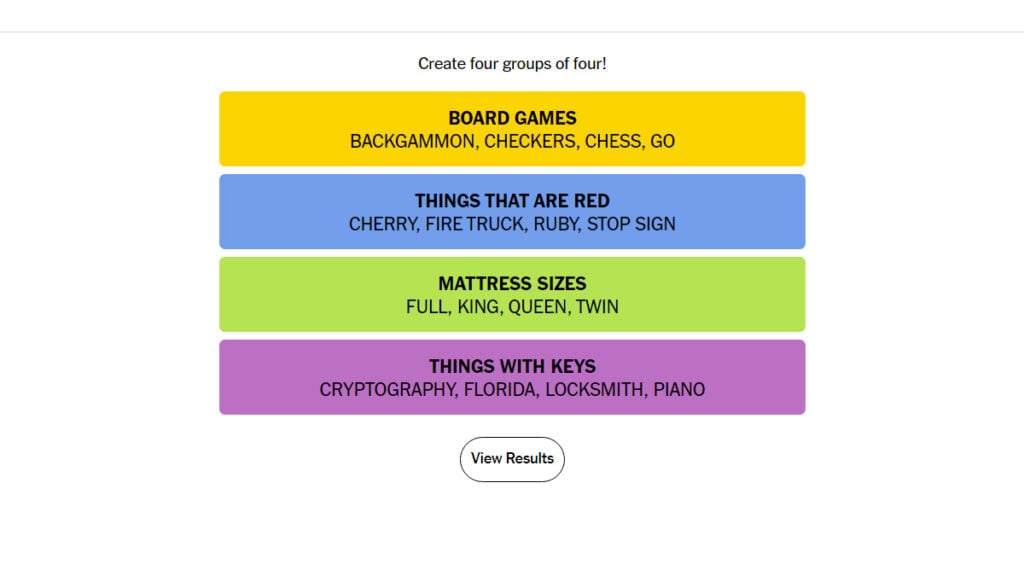The New York Times (NYT) has captivated readers with its innovative puzzles and games, launching a new favorite among enthusiasts: NYT Connections. As players delve into this word-connection game, they must identify groups of four words that share a common theme. This article aims to provide key hints and strategies specifically for the April 19 edition, ensuring players can maximize their chances of success while enjoying the challenge.
Understanding NYT Connections

Before diving into specific hints for April 19, it’s essential to understand how NYT Connections works. The game presents players with a grid of 16 words, from which they must form four groups of four related words. The challenge lies in recognizing patterns and themes that connect the words, which can range from common categories like animals and colors to more abstract connections like emotions or actions.
Why is NYT Connections Popular?
NYT Connections has surged in popularity for several reasons:
- Cognitive Engagement: The game exercises mental agility, promoting problem-solving skills and vocabulary enhancement.
- Community Interaction: Many players share tips and solutions on social media platforms, fostering a sense of community.
- Daily Challenge: The game’s daily updates keep players returning, making it a routine part of their day.
Key Strategies for Success

Success in NYT Connections hinges on a few key strategies. Here are some effective approaches to keep in mind:
1. Start with Obvious Connections
When faced with the grid of words, begin by identifying any immediate connections. Look for:
- Synonyms: Words that mean the same or have similar meanings.
- Antonyms: Words that express opposite ideas.
- Categories: Words that fit into clearly defined groups (e.g., fruits, colors, professions).
For example, if you see “apple,” “banana,” “cherry,” and “grape,” it’s clear they belong to the fruit category. Identifying such obvious connections can help unlock the grid faster.
2. Think Outside the Box

Not all connections are straightforward. Some may require lateral thinking. Consider:
- Homophones: Words that sound alike but have different meanings.
- Pop Culture References: Words linked through movies, songs, or books.
- Historical Context: Associations based on historical events or figures.
For instance, if the words “bat,” “catcher,” “home,” and “run” appear, they may link through baseball terminology rather than the more obvious connections.
3. Use a Process of Elimination
If you find yourself stuck, apply a process of elimination. Here’s how:
- Group Words: Start by grouping words that seem to fit together, even if you’re unsure.
- Remove Outliers: Identify which words do not fit with the groups you have formed.
- Re-evaluate: Look at the remaining words and see if new connections emerge.
Hints for April 19 Edition
Now, let’s dive into specific hints for the April 19 NYT Connections. While I can’t provide the exact words, I can guide you on how to approach the grid based on common word themes:
1. Colors and Shades
Colors are a frequent theme in NYT Connections. If you notice words that describe colors or shades, try grouping them together. Keep in mind:
- Primary Colors: Red, Blue, Yellow
- Shades: Indigo, Magenta, Cyan
2. Animals and Nature
Another common category revolves around animals or elements of nature. Look for connections among:
- Mammals: Dog, Cat, Elephant
- Birds: Sparrow, Eagle, Penguin
- Natural Elements: Water, Earth, Air
3. Emotions and States of Being

Words that describe emotions can sometimes form a group. If you see terms like joy, sadness, anger, or love, consider grouping them together. Remember to think about:
- Positive Emotions: Happiness, Joy, Excitement
- Negative Emotions: Anger, Fear, Sadness
4. Professions and Roles
Many puzzles include words related to professions or roles. If your grid contains words like doctor, teacher, engineer, or chef, they likely belong to this theme. Here are some to consider:
- Healthcare: Nurse, Dentist, Pharmacist
- Education: Professor, Tutor, Instructor
- Technical: Programmer, Developer, Analyst
Case Studies: Successful Players
To further illustrate effective strategies, let’s look at a few case studies of successful NYT Connections players:
Case Study 1: The Systematic Solver
Emily, a dedicated puzzle enthusiast, approaches NYT Connections with a systematic method. She starts by categorizing words into groups before attempting to make connections. By using color-coded notes, she quickly identifies potential themes, leading her to solve the puzzles efficiently.
Case Study 2: The Social Solver
James, on the other hand, thrives on community interaction. He often shares his progress on social media and engages with fellow players to exchange hints. This collaborative approach helps him gain new insights and strategies, ultimately enhancing his gameplay experience.
Navigating the NYT Connections puzzle on April 19 requires a blend of strategy, creativity, and community engagement. By employing the outlined strategies—starting with obvious connections, thinking outside the box, and utilizing a process of elimination—players can enhance their chances of success. Additionally, familiarizing oneself with common word themes such as colors, animals, emotions, and professions can provide a significant advantage in grouping related words.
The popularity of NYT Connections continues to grow, and with the right approach, players can enjoy the challenge while improving their cognitive skills. Whether you’re a seasoned player or new to the game, these insights will help you tackle the April 19 edition with confidence. Happy puzzling!